Updated: 11/11/2024
Request from Stalin
The Blitzkrieg, invented by Heinz Guderian, Erich von Manstein and Erwin Rommel, had ensured that countries such as Belgium, the Netherlands, Luxembourg, France and in the east countries such as Poland, Hungary, Czechoskia were overrun by the Wehrmacht in no time. Hitler, in his face with these successes, then, despite a non-aggression treaty with Stalin, decided in a mood of total self-overestimation, to also conquer Russia and exterminate communism.
The operation Barbarossa also initially went from a slate roof until the moment that the Blitzkrieg came to an abrupt standstill due to fierce opposition, the bad weather and faltering logistics at Stalingrad. It enabled the Russians to build up the necessary reinforcements far away from the front, both in terms of equipment and trained men. Eventually the Wehrmacht could be stopped on all fronts and a counter-attack could be started, led by Georgie Zhukov and Ivan Konev to reduce the Wehrmacht as far as possible.
Allied leaders


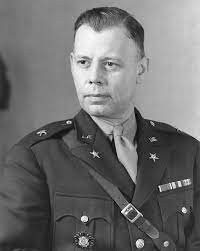
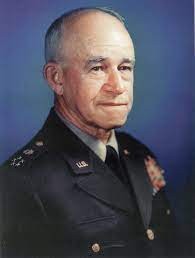



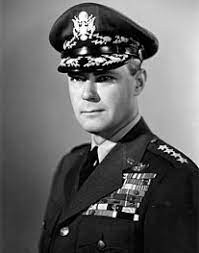
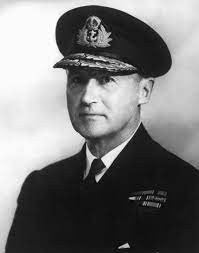
The invasion of Normandy actually took place at the request of Stalin, who asked for a 2nd front in Europe, in order to allow the attack from two sides to take place. Stalin had previously devised the equivalent of Operation Overlord, Operation Bagration, along with Zhukov, Vasilevsky and General Antonov.
The French Resistance
During the evening of 1 June 1944, the headphones will resurface at the French resistance. “Ici Londres” sounds a familiar voice. After a few cryptic messages, the long-awaited sentence “Les sanglots longs des violons de l’automne” suddenly follows. It is the first stanza of the poem Chanson de l’automne by the French poet Paul Verlaine. The message is intended to sharpen the French resistance. On 5 June 1944, the second line “Blessent mon coeur d’une longue monotone” followed. The invasion will start within 24 hours.
Juan Pujol

Double spy and king of deception. One of the allies’ most important weapons. He began working for the Germans as “Arabel.” Later he decided to take the side of the Allies and thus became a double spy under the name “Garbo”. He maintained his contacts with the Germans (via Madrid) by radio and by letter. The radio messages were drafted by his British executives, over which he poured a beautiful Spanish sauce.
He played an important role in putting the Germans on the wrong foot by mirroring to them that the invasion at Calais would take place. To this end, a fictional army of inflatable tanks and other vehicles led by George Patton was deployed (Operation Fortitude-South). The Wehrmacht did indeed leave its armored troops in northern France because it was thought that the invasion in Normandy was a distraction.
10 Days to D-Day
In a London suburb of Hendon, a man sat deep over a radio station, tapping out a secret coded message. Now that the tide of the war began to turn strongly against the Germans, Berlin was trying to gather as much information as possible about the Allies. The experiences of the past 2 years had taught the German Abwehr that Arabel could be fully trusted. More and more pressure was being put on Arabel to have his “agents” gather information about the imminent invasion. Only a handful of people knew the answer to the Abwehr’s question and those were not the English secret agents, the French resistance man, the German soldier, the American paratrooper or the Canadian infantryman. The secret of D-Day is among the most important secrets ever kept.
Hitler had for a long time assumed that a possible invasion would take place somewhere along the narrowest part of The Channel. This conviction was incorporated in Bevel 51, which Hitler had issued in November 1943 and which had since been at the basis of the entire German defence tactic. Yet a few months later, in April 1944, he suddenly had it over Normandy and Brittany as one of the possible targets that had to be taken into account. There was no clear reason why he had suddenly changed his mind. He also held on to a thought that the Allies would strike in Norway, by way of a diversionary manoeuvre. He therefore insisted that a significant occupation army remain stationed.
Rommel was a serious and driven man. He had been appointed by Hitler to prepare the defense of Western Europe under his command for an Allied invasion. The result was that France’s coastline was littered both above and below the flood line with a bewildering amount of anti-invasion barricades. Rommel was convinced that the war on the beaches would be won or lost with only one chance to stop the enemy and that is if he is still on the water.
Glenn Dickin
Glenn Dickin was one of tens of thousands of infantrymen to be transported by the armada from ships to the D-Day beaches. Glenn’s camp was one of twenty-two who were in the area and bursting at their joints with a total of more than fifty thousand troops and seven thousand vehicles. Each camp was divided into blocks of fifty pyramid-shaped canvas tents, which were again divided into “villages” of ten. Ten soldiers slept in each tent. Petty officers and officers had more comfortable lodgings. The camps all had their own facilities, own kitchens, latrines, showers, shops and leisure opportunities.
In Berlin, Hitler’s Minister for Public Information and Propaganda, Joseph Goebbels, sent a message to representatives of the media and military reporters, that Hitler and the high command had foreseen all the eventualities and had the events tightly in hand. The Germans did not have to fear for their future.
Eisenhower was still in Telegraph Cottage, his beloved refuge, where he focused on the task ahead. Behind his broad smile, easy way of doing things and a sense of humor went into an iron will and incredible self-control. Roosevelt had chosen him as Commander-in-chief, and Churchill had agreed to this, because he had brilliantly demonstrated his ability to lead the Anglo-American armed forces during the landings in North Africa, Italy and Sicily. “As the pressure rises and the tension rises”, he told his wife Mamie, “the weaknesses in his character come up in everyone. It is up to the commander to control his own and above all to hide doubt, fear and distrust”.
Eisenhower offered De Gaulle to show his liberation message that he wanted to release on D-Day. De Gaulle immediately saw that he and his Committee for National Liberation were not mentioned in it and that the French people were asked to obey Eisenhowers orders. After some frosty comments back and forth, Eisenhower said he could see if he could do anything about the text. De Gaulle had promised to stay with Churchill. Instead, he got in his car houghly and left for London on his own.
The rain fell with bins from the sky and the wind pounded against his trailer when Eisenhower got up at half past four on June 5 and went to Southwick House. Eisenhower and his commanders took a seat in their easy seats and went to work. No one laughed because this was the decisive moment. Either the invasion went ahead or a new date had to be set. James Stagg, head of the RAF’s metrology service, said: “No substantial changes have occurred since the last time and, in my opinion, the little that has changed gives rise to some optimism.” When Eisenhower heard the details, a smile appeared on his tight face. “Stagg”, Eisenhower said, “when this prediction comes true, I promise to build you a party in due course”. Then Eisenhower spoke the historical words “Okay, let’s go”.
D-Day
D-Day, June 6, 1944 is in the history books as the equivalent of the invasion of the beaches of Normandy. The “D” in D-Day means nothing. Many speak of “Decision day”, but that was certainly not the meaning. The “D” was actually a simple letter in the communication about “D-Day”. If something had to happen a day later, one spoke in the plans of “D+1”, a week earlier “D-7”.
The invasion on the Norman beaches consisted of 3 parts, all under the name Operation Overlord. Operation Neptune was phase 1 of Overlord and involved all acts that took place at sea for the transport of troops and materials to the beaches and the attack and security of the airports. Phase 2 was the breakthrough from the front to the Seine and from the ports of Cherbourg and Brittany. Phase 3 ended with the liberation of Paris.
The Invasion Beaches
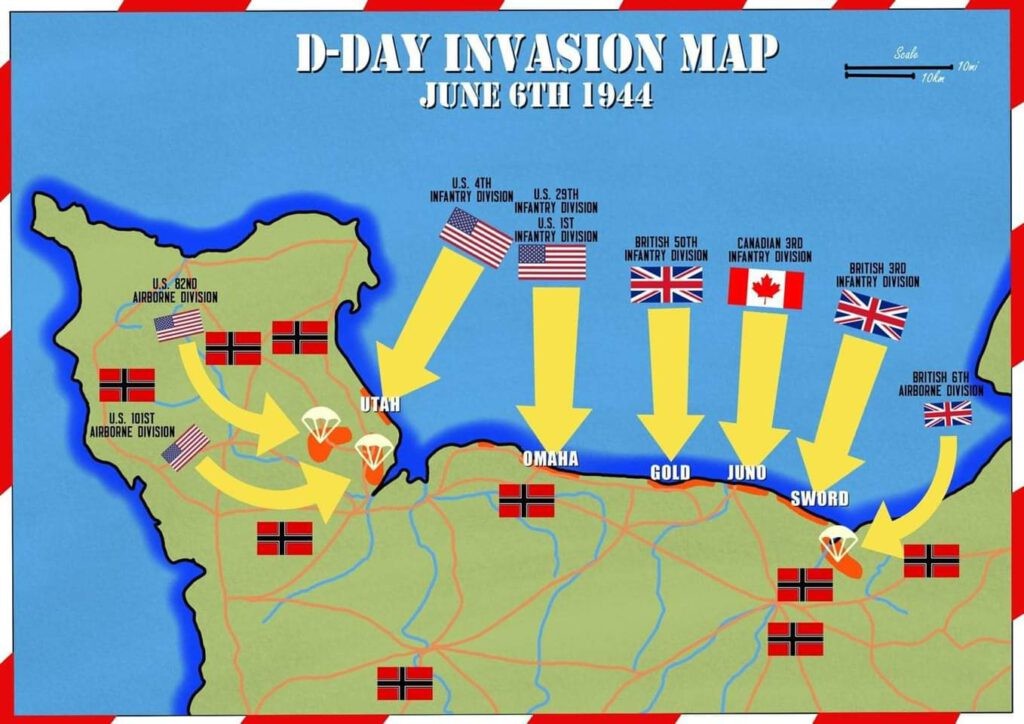
Furthermore, there was “a forgotten beach”, the sixth beach “Band”, north of Sword beach, which was not used in the end.
German divisions in the coastal area
The 716th Infantry Division defended the eastern half of the landing zone, including the British and Canadian beaches. The division consisted mainly of German soldiers, soldiers of Poland and Russian prisoners, who were rejected for the Eastern Front.
The 352nd infantry division defended the area between Bayeux and Carentan, including Omaha beach. This division was a well-trained and well-equipped division that contained many Eastern front veterans.
The 91st airborne division defended the Cotentin peninsula, where the U.S. airborne landings were later carried out.
The 6th paratrooper regiment defended Carentan. They had to prevent the Americans from Omaha beach from making contact with the troops of Utah beach.
The 709th Infantry Division defended the eastern and northern part of the Cotentin, including Cherbourg and Utah beach. This division also consisted of disapproved German soldiers from the Eastern Front.
The Allies
The landings took place on Utah beach, US 4th infantry division (Ivy), Omaha beach, US 29th and 1st infantry division (Big red one), Ponte-du-Hoc, US 2nd Ranger Battalion, Gold beach, British 50th infantry division, Juno beach, Canadian 3rd infantry division and Sword beach, British 3rd infantry division.
6 June 1944
Erwin Rommel is in Germany to celebrate his wife’s birthday. Adolf Hitler is asleep and no one dares to wake him up. Because Hiltler himself coordinates all troop movements, no direct action is taken and the much-needed armoured divisions for the Germans remain in the north near Calais.
In fact, the entire organization of the Germans on June 6 was one big chaos. Hitler wanted to make all the decisions himself. The Wehrmacht generals at that time already began to doubt the loyalty towards Hitler, Gerd von Rundstedt, responsible for the defense of the Normandy coast, was not exactly a friend of Erwin Rommel who was responsible for the defenses of the Atlantic Wall.
The paratrooper droppings and glider landings
Before the landings took place, there were important paratrooper droppings, which had to secure a number of crucial points for a quick passage of the infantry. Droppings above Sainte-Marie-du-Mont, U.S. 101st Airborne division, droppings over Sainte-Mere-Eglise, U.S. 82nd Airborne division, droppings at the Merville battery, British 6th Airborne division with the aim of destroying the Batterie de Merville and defending the left flank of the landing area of Sword.
Furthermore, there has been a miraculous attack with gliders, led by John Howard to secure the important bridge at Bénouville, the bridge over the Orne. John Howard managed to land with 3 gliders almost to the bridge and, to the great surprise of the Germans, take the bridge in a very short time.
The paratrooper droppings quickly became a great chaos due to the poor visibility and violent defense guns of the Germans, causing many aircraft to be shot out of the sky or dropping their paratroopers in the wrong place. Eventually on the ground, the 101st could fairly easily continue their way. Sainte-Marie-du-Mont was the first place to be taken without too much resistance.
Otherwise it went with the 82nd. Many were dropped in the square in front of the church of Sainte-Mere-Eglise and killed directly by the Germans. Sainte-Mere-Eglise is still known for the landing of John Steel, which stuck to the roof of the church with his parachute. Although John lingered on the other side of the church, there is now a doll hanging on the side of the square. John Steel was eventually captured but managed to escape and rejoined his division.
Utah Beach
At 6:30 a.m., the landing craft were carried away by a violent current from the beaches where they should have actually landed. Despite this, the first men set foot at the agreed time. The drifting later proved to work in favor. They landed in a weakly defended area, the only threatening object of which, was a bunker with a cannon where no activity could be seen. In a short period of time, 600 troops, including General Theodore Roosevelt Jr., eldest son of the president, managed to reach the beach. The bunker was quickly knocked out without any significant losses. The 4th Infantery division made contact with the 101st Airborne paratroopers at 13.00.
Omaha Beach
It was very different at Omaha Beach. The bombing on the German defensive line the night before June 6 had done little. Most of the bombs had fallen behind the defensive lines because of the poor visibility. At 6:35 a.m., the first landing craft opened their valve, if they had already been able to reach the beach. The beach was one big inferno of sounds and bullet rains and most of the men never reached the beach. The small number of tanks that the men should have helped were soon eliminated. During the landing waves, it became one big chaos on the beach.
Omaha, exit Vierville-sur-Mer – 29th Infantery division (Norman Cota), 5th Ranger battalion (Max Schneider) and part of the 2nd Ranger battalion that did not participate in the ascent of Pointe du Hoc.
Omaha, exit Saint-Laurent-sur-Mer – 1st Infantery division (Big Red One – George Taylor)
320th Barrage Ballon battalion – African-American unit, which had to boost hydrogen-filled balloons for the beach air defenses
The new troops were immediately eliminated or pinned down on the beach. Norman Cota, Lieutenant-Commander of the 116th Infantery regiment of the 29th Infantery division, managed to organize the remaining troops and make some progress. Also George A. Taylor, commander of the 16th Infantery regiment of the 1st Infantery division, succeeded with the following slogan “There are two of men who will stay on this beach, the dead and the ones that are going to die, so let’s get out of here fast”, get the remaining men moving. Little by little and with big losses, the troops managed to get over the dunes.
After a few hours, the German defenses and using two destroyers, the Emmons and the Doyle, managed to sail very close to the beach, turning off the coastal batteries. Due to lack of reinforcements and ammunition, the German opposition was eventually neutralized.
Pointe-du-Hoc
Pointe-du-Hoc was a fortified position between Utah and Omaha Beach and was believed to have six powerful cannons who had full control over both beaches. 225 Rangers from the US 2nd Ranger battalion, led by Colonel James Rudder, were ordered to check whether the cannons had been knocked out by the bombing.
In order to do this, the steep rock had to be climbed. At 7:10 a.m., the Rangers started this job. Under fire from German machine guns and many grenades, thirty metres above them, the first three Rangers reached the summit within five minutes. When several Rangers arrived, the Germans were driven back and the battery was taken. This had since been abandoned and….. no cannons were found either (see also “Strategic decisions that mattered – Pointe-du-Hoc”).
Gold Beach
At 7:25 a.m., the landing was deployed. Despite constant fire from coastal defenses, the 47th Royal Marine command managed to reach Saint-Come-de-Fresne around 8:00 a.m. In central Gold, the tanks were stopped by an anti-tank battery in Le Hamel. Around the middle of the morning, one of the tanks managed to completely blow up the bunker and create various exits to the interior. From here, the attack on Bayeux was massively launched. Bayeux fell into the hands of the Allies without significant damage and was the first major city to be liberated. After that, attempts were made to make contact with the Americans who had landed on Omaha.
Juno Beach
Juno became the most bloody beach in the Anglo-Canadian sector. At 7:55 a.m. the attack was launched, but the German coastal defences had barely been damaged by the bombing and opened fire on the Canadians. Of the 306 vessels, 90 were destroyed, 950 soldiers were killed, wounded or missing.
Hobart’s funnies (tanks equipped as a mine-sweeper), eventually brought a solution and managed to clean up mines, barbed wire and bunkers to give the infantry the opportunity to create the units that were stuck on the beach a passage to the hinterland. Courseulles was liberated at 9:30 a.m., at 11:30 a.m. Saint-Aubin. However, this did not go without a fight. Heavy man to man fighting in Saint-Aubin and Bernieres were needed to achieve this and slowed Canadian progress. The goal of reaching Carpiquet airport near Caen for the incursion of darkness had to be adjusted several times during the day.
Sword Beach
At 7:25 a.m., the first troops of the British 3rd infantry landed. Using Lord Lovat’s 1st Special brigade, they had to make contact with the units that had managed to take the bridge at Bénouville. The plan after that was to continue together and free Caen. Again thanks to the Hobart’s funnies, the coastal defenses were quickly settled.
Opening passages to the hinterland was less easy, creating a large amount of manpower and vehicles on the beach. which could not easily push through. Finally, after a few hours, they managed to force four passages through the minefields and take Hermanville. About 600 troops were wounded or killed.
Further east in Ouistreham, fierce man to man fighting was carried out and it took until 12:00 noon for the Allies to neutralize the Germans. The only French unit, under the command of Philippe Kieffer, has distinguished itself by taking the casino converted by the Germans into fortress, although at the loss of half unit of wounded or dead. Finally at 14:00, Lovat’s and Kieffer’s men were able to join the men of the bridge at Bénouville. While Bill Millin was playing “Blue Bonnets over the ocean” on his bagpipe, the bullets flew around his ears.
The Mulberry Harbours
After the conquest of the beaches and the securing of the underlying areas, it was important to build two artificial ports for supplying equipment and supplies as soon as possible. Two fully equipped ports were brought in parts by boat from England. The most famous artificial harbour was built at Arromanches in the Gold beach area.
The second port was built at Saint-Laurent-sur-Mere in the Omaha area. These two artificial ports remained in use until major French ports were conquered. The port at Arromanches was used for 10 months, through this port 2.5 million troops, 500,000 vehicles and 4 million tons of supplies were brought. The second port at Saint-Laurent-sur-Mere was damaged on June 19, not yet completely finished, by a violent storm that lasted three days, in such a way that the port had to be given up.
Construction of the artificial port
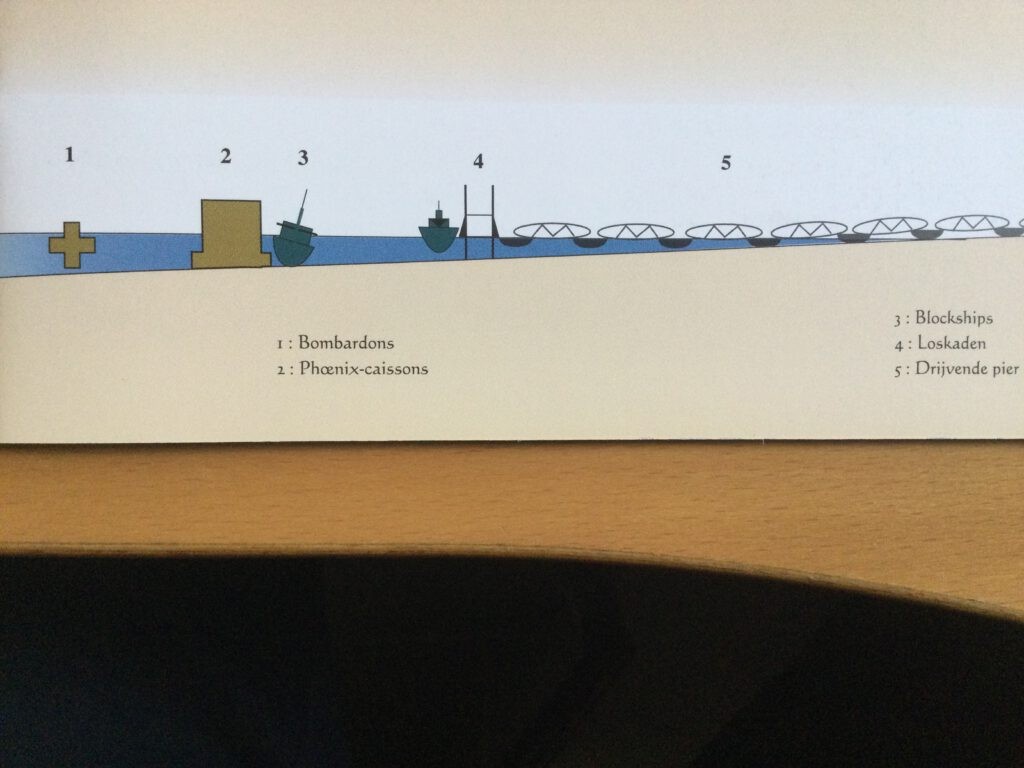
1. A first breakwater consisting of a series of anchored, cross-shaped floats (bombardons).
2/3. A second fixed breakwater consisting of concrete caissons (Phoenix) and sunken old ships (gooseberries).
4. Anchored floating loose quays, to which the ships could moor.
5. Floating piers for the connection to the beach.
Pipe-Line Underwater Transport of Oil
The supply of oil was mainly carried out by tankers, which could dock in the artificial ports. The supply of ships brought with it a risk factor; these ships were in danger of being torpedoed by German submarines, or delayed by the bad weather. As a result, it was decided to build a pipeline from England to the French coast. One of these pipelines ended in Port-en-Bessin. A lot of fuel was not supplied and on 10 October 1944 the pipeline was put out of use.
On 12 August 1944, a pipeline to Cherbourg was put into use. In January 1945, 305 tonnes of fuel were pumped to France a day, rising to 4000 tonnes a day at the end of the war.
In total, 781,000 cubic meters of fuel has been pumped through the Pluto pipes.
Harold Baumgarten – Omaha
Harold Baumgarten is a 19-year-old Jewish boy from the Bronx. As his boat approaches the west of Omaha Beach at 6:30 a.m., a grenade in the boat next to it strikes, after which it rains body parts and metal splinters on Harold and his startled comrades. The young British helmsman of the landing craft does not dare to sail further and wants to lower the valve in six meters deep water to sail back quickly. Harold’s lieutenant gets angry and points his Colt 45 at the helmsman. “You take us all the way to the beach” he commands. But if the valve finally goes down, the lieutenant is immediately killed by machine gun fire. Moments later, more men drop down for Harold. The water turns red from the blood and when Harold himself jumps, a bullet just misses him. He stands up to his neck in the water and holds his rifle over his head. As he struggles his way to the beach, bullets splash the water around him. As Harold approaches the waterline, he runs with his rifle in front of his chest until a German bullet ricochets and makes his entire body vibrate. A grenade that explodes right in front of him strikes a wound in his left cheek, after which he feels his gums and molars lying on his tongue. In the middle of the grenade rain, a medic runs towards Harold and begins to take care of his wounds. Harold eventually reaches the first shelter against the German shelling. He throws himself on the ground and rests, defeated and shocked. He is just one of the two soldiers of his entire landing crew who survive the landing.
Werner Pluskat – Omaha
It has become known from the film The Longest Day, Pluskat sees the armada coming. His communication with the division headquarters is legendary, although this is a Hollywood interpretation.
Pluskat: It’s the invasion! There are more than a thousand ships there!
HQ: Which way do the ships sail?
Pluskat: Right on me!
A few minutes later HQ: What’s the situation?
Pluskat: We are shot and bombed!
HQ: What is the location of the bombing?
Pluskat: My god man, it’s raining bombs and bullets here. What do you want me to do? Go outside and measure the impacts with a ruler?
There is doubt about the story of Werner Pluskat, especially by the criticism of Heinz Severloh, shooter on Omaha, who claims that Pluskat was not at his post. Yet there will have been a German soldier somewhere on Omaha or the other beaches who is familiar with this experience.
Karl Wegner – Omaha
Karl Wegner is located near the strategically important road to the village of Vierville. “Fire Wegner, fire,” his commander roars as the first Americans jump out of the landing boats. But Karl stares as if in a trance at the Americans who make their way through the water to the land. With a metallic sound, his commander smacks his gun pump against Karl’s helmet, making him come to his senses and pull the trigger. He barks his MG42 and occasionally an American soldier collapses. Karl has plucking cotton wool in his ears to dampen the noise and the sweat flows along his face. Comrade Willi ensures that the ammunition remains clean and the machine gun does not get stuck. Karl has long since stopped listening to orders and fires on them, while the bodies of the dead and wounded Americans accumulate on the sand along the water. Karl suddenly sees something moving outside. His commander sneaks to the bunker door and drags a wounded German soldier inside. From the story of the soldier it can be seen that after the shelling of his bunker, his other comrades did not want to fight any further. Karl’s commander becomes white-eated, grabs some grenades and runs off at the bunker, where he throws the grenades against the racks. If the dust has settled and he wants to return, a salvo from a landing boat becomes fateful to him. Karl and his comrades are in shock. Their commander is the first one they know who dies in battle.
Tom Rice – Sainte-Marie-du-Mont
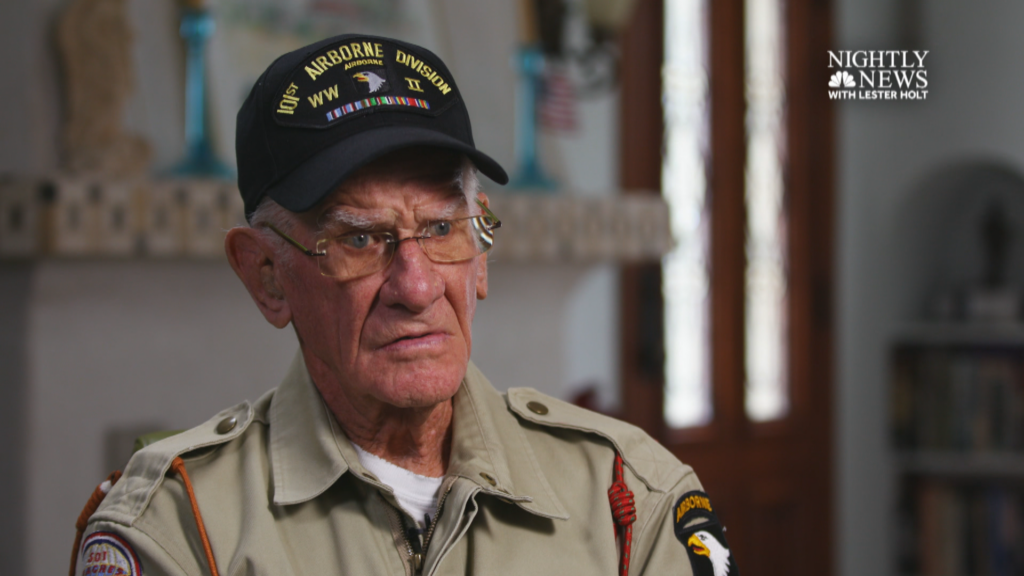
I have met Tom Rice a number of times at the D-Day Experience museum in Normandy. Tom was born on August 15, 1921 and recently died on November 17, 2022.
When Tom arrives above drop zone “D” in his C47 with 17 other paratroopers led by Lieutenant Janssen, the aircraft is heavily attacked. A grenade hits the plane and soon it becomes a chaos inside. The plane flies through and the men are dropped many miles from their landing site. Tom manages to detach himself from the aircraft and his parachute opens 100 meters above the ground. Due to the excessive speed of the C47, the paratroopers landed across a large area. One of the men, Marvin Buskirk lands in the sea, but still manages to get rid of his equipment and swim to land. After a hectic landing, Tom comes to his positives, checks his Thomson and explores the surroundings. He finds a few comrades and sees that he has landed near a canal (Carentan). More and more men are emerging and joining the group. Lost, they must now find a landmark to see where they are. Eventually, they reach a remote farm. The resident anxiously opens the door. He does not speak English and with hand gestures he shows the men where they are, 2 kilometers north of their intended goal. Not knowing that Lieutenant Colonel Caroll, commander of the 1st batallion 501st PIR has been killed and that his right hand man, Major Philip Gage has been wounded and captured, the men continue the way to their target. A few minutes later they arrive at La Basse-Addeville.
Because it’s getting lighter and the vision gets better, Tom meets a lieutenant who belongs to another group. The group cannot continue because they are under attack by a German sharpshooter of which they cannot determine where exactly it is. The lieutenant orders the group of 501st PIR to cross a field like a kind of bait in order to locate the sharpshooter. Reluctantly, they cross the field without the desired result. They gather at a few houses and discuss how they can get more ammunition. First Sergeant Franck Ficarotta volunteers to return to the landing site, but is immediately struck by a shot from the sharpshooter. The group decides to discreetly sneak from home to Basse-Addevile along a narrow road. They come across Major Allen of the 501st PIR who manages to gather about 100 men and move forward together. Tom and the men cross the intersection from Basse-Addevile to La Barquette, which is soon called “Hell’s corner.” They know how to take La Barquette and dig themselves in to protect themselves from heavy artillery and mortar fire from Carentan and Saint-Come-du-Mont. After this, Tom will take part in the fighting on 7 and 8 June to broaden the bridgehead towards Carentan.
After the Battle of Normandy, the division was brought back to England to prepare for the Market-Garden operation. On 17 September 1944, Tom was dropped over the Netherlands and later also participated in the battle of the Ardennes from December 1944 to January 1945. Tom was badly injured and was evacuated from the front to be cared for. But he stayed in Europe and later took part in the fight around Hitler’s Eagle’s Nest in Berchtesgaden.
D-Day in numbers
Allied soldiers:
Infantry: 1,700,000 British soldiers, 1,500,000 U.S., 175,000 Canadian and 44,000 other allied soldiers. Total 3,919,000.
Marine:
British Navy: 3 battleships, 17 cruisers, 65 destroyer hunters, 360 coastal vessels and 447 frigates, corvettes, minesweepers and other accompanying vessels. 3261 landing ships and vessels.
U.S. Navy: 3 battleships, 3 cruisers, 34 destroyers, 111 coastal vessels and 49 frigates, minesweepers, patrol vessels and other escort vessels. 865 landing ships and vessels.
Other Allied countries: 49 warships.
Air Force:
3440 Heavy bombers, 930 medium bombers, 4190 fighter bombers, 1360 troop transport aircraft, 520 scouts, 80 sea/air rescue and 1070 Coastal Command aircraft.
Estimate number of victims from 6 to 20 June 1944:
American: 125,846 dead and wounded.
British and Canadian: 83,045 dead and wounded.
Germany: 393,689 dead, wounded and prisoners of war.
French population: between 15,000 and 20,000 deaths.
Finally
So much for the story of the landings on the beaches and the first conquests of the hinterland. There were then fierce fighting at the rise, resulting in many, very many casualties on both sides. Taking Caen, St. Lo, Villiers Bocage and many other cities and places often went very laboriously and took a lot more time than expected.
Eventually the Americans, English, Canadians and Poles met in the Falaise pocket (operation Cobra), where they were able to surround the Germans on July 25, 1944. Many thousands of German soldiers were captured and a lot of German equipment could be destroyed.
The battle won at Falaise paved the way for a quick passage to Paris. Paris was liberated on August 19, 1944 and also marked the end of the operation Overlord.
Source
Ten days to D-Day, David Stafford
The D-Day landings, Jean-Bernard Moreau
The Mulberry Harbours, Alain Ferrand
Various Wikipedia and Historianet articles
Biography Tom Rice – Dday-Overlord.com